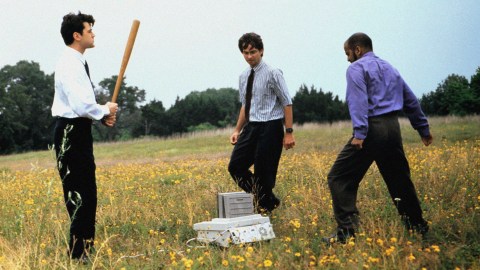Combat “quiet quitting” with an experience mindset

- Quiet quitting is a new(ish) name for a decades-long problem.
- To combat quiet quitting, organizations can’t sacrifice the employee experience in pursuit of customer satisfaction.
- Start by building a foundation of trust that allows employees to express themselves freely and offer honest feedback.
The practice of “quiet quitting” isn’t anything new. In the cult satirical movie Office Space, protagonist Peter Gibbons, played by Ron Livingston, had quietly quit his job at the fictional corporate hellhole Initech long before the story even started. As he admits, his typical day consists of him sneaking in late and staring at his desk for hours.
“I’d say in a given week, I probably do about fifteen minutes of real, actual work,” Peter says. “My only real motivation is not to be hassled, that and the fear of losing my job. But [that] will only make someone work just hard enough not to get fired.”
That quote is textbook quiet quitting — and remember: Office Space came out in 1999. Twenty-five years ago.
The data backs this up. Gallup survey results show that only 33% of U.S. employees were engaged at work in 2023. That’s low but only a three-point dip from 2020’s high of 36%. Look further back in the data, and you’ll notice that 33% is slightly above the engagement average for the entire aughts and much higher than the 25% low of 2000.
The only thing novel about quiet quitting is the name — which is, admittedly, quite catchy. That’s not to say it’s not a problem; it’s just a problem organizations have been facing for some time.
“If quiet quitting does die, it will be because the term is no longer cool on TikTok,” Jon Clifton, CEO of Gallup, writes. “But the feeling behind the trend isn’t going anywhere.”
Organizations aren’t without recourse though. According to executive advisor Tiffani Bova, quiet quitting can be remedied and employee engagement boosted. To start that process, leaders must shift toward what Bova calls the “experience mindset.”

What is the experience mindset?
Bova describes the experience mindset as the “virtuous cycle between happy employees and happy customers.” Customers’ experiences tend to be excellent when employees are willing to go above and beyond to meet their needs. At the same time, employees’ experiences tend to be excellent when they are engaged, open to collaboration, and able to derive satisfaction from their role.
The cycle is virtuous because happy employees lead to happy customers, which leads to growth. But notice something about that statement: It starts with the employees.
“If your employees aren’t happy, there’s no way to get the lift or the improvement in growth on the customer side,” Bova tells Big Think+.
But what has disrupted that cycle in recent decades? As with any long-lasting, large-scale trend, there are many causal factors at play, but Bova lays some of the blame on the digital revolution. As organizations focused on reducing friction on the customer side, they subsequently increased the barriers faced by employees and the effort necessary to overcome them.
Bova offers an example from e-commerce: ever-shorter delivery times. Obviously, customers prefer receiving their purchases sooner rather than later. However, the push to bring times down from five days to two days to next day placed unrealistic expectations and pressures on employees. Customer satisfaction may have soared, but the employee experience suffered in turn.
Another cause is a sharp decline in role clarity. According to Gallup, fewer than 50% of employees know what is expected of them on any given day — a group that includes onsite, remote, and hybrid workers. Unsurprisingly, knowing what you’re supposed to do at work correlates with productivity, well-being, and engagement.
Those are just two causes of quiet quitting, and potential solutions will vary depending on the cause as well as the industry. With that said, an underlying principle for those solutions will be the need for leaders to shift to an experience mindset.
Don’t hire Lumberghs
“An easy way to start to shift your mindset is to view your internal employees as customers as well,” Bova says. “They’re also shareholders in the success of the organization. It is two sides to the same coin.”
And when it comes to customers, the coin of the realm is trust. Just consider all the strategies organizations employ to build and maintain customer trust in their products, services, and brand. They invite customer feedback and act on those responses. They offer meticulous support to help customers get the most out of products and services. And they initiate relationship-building by going to the customer and ensuring the connection is as seamless as possible.
Given this, a great way to start rebuilding the employee experience would be to look for comparable practices you can bring in-house. One such practice is to foster norms and systems for continuous, honest communication.
Once again, Office Space recognized the problem years ago. The movie makes a villain of Initech vice president Bill Lumbergh, played brilliantly by Gary Cole, not because he’s actively evil. It’s because he simply doesn’t listen or care. He greets employees with a halfhearted “What’s happening?” but ignores what they have to say and immediately drops a barrage of micro-managerial commands on them.
Organizations looking to rebuild trust — and rehabilitate their Lumberghs — already have the tools and capabilities to open up healthy communication. They simply need to prioritize them.
Organizations can use surveys and needs analyses to help identify support and training gaps. They can schedule time and space for employees to build relationships and share ideas. And one-on-one meetings with managers can offer employees the chance to air concerns, get role clarity, and receive support. All of which should be spearheaded by leaders, rather than expecting employees to initiate.
That said, Bova warns that building healthy trust and communication will take time and patience. She recommends starting slow. Offer opportunities for employees to offer anonymous feedback, and then use those to show employees that honesty won’t harm their careers and future opportunities. Then find other ways to prompt people to be more open. Leaders will know they’re on the right track when employees openly and publicly volunteer opinions and information.
“Trust is really the bedrock of the culture of a company,” Bova reminds us.
Building toward a new trend
Of course, it doesn’t stop there. Other things organizations can do to combat quiet quitting and improve the employee experience include: offering career support on par with customer support; retrofitting processes and digital tools to be as user-friendly as possible; and finding meaningful ways to build employee loyalty (such as career advancement opportunities), to name a few.
Will it ever be a perfectly virtuous cycle between the happiness of employees and customers? No, says Bova. But by recognizing the need to care for the employee experience with the same diligence afforded customers, leaders put their organizations in a better place to recognize burnout and dissatisfaction before they infect company culture.
“It’s all the little things that make up the success of the organization. That is a competitive differentiator that is much more difficult to try to replicate,” Bova points out. “[But] the best way to get customers to love their brand is to get employees to love their job.”





